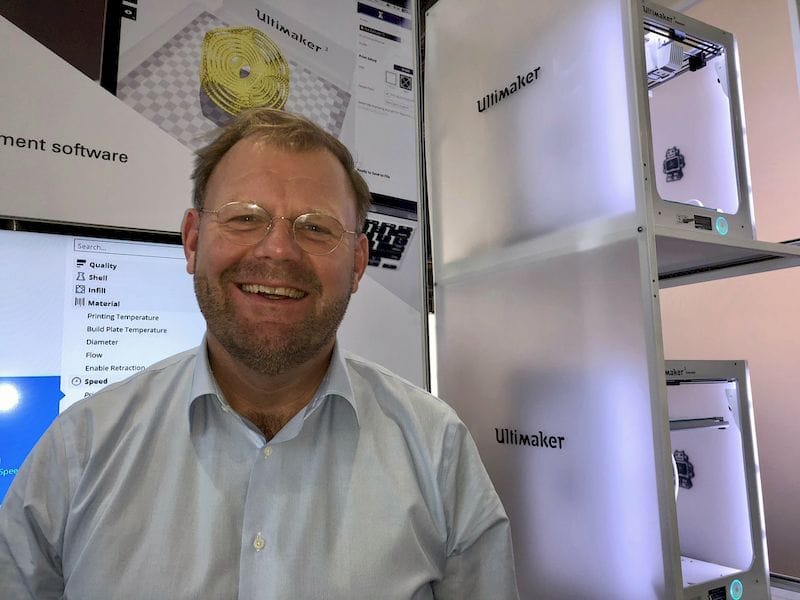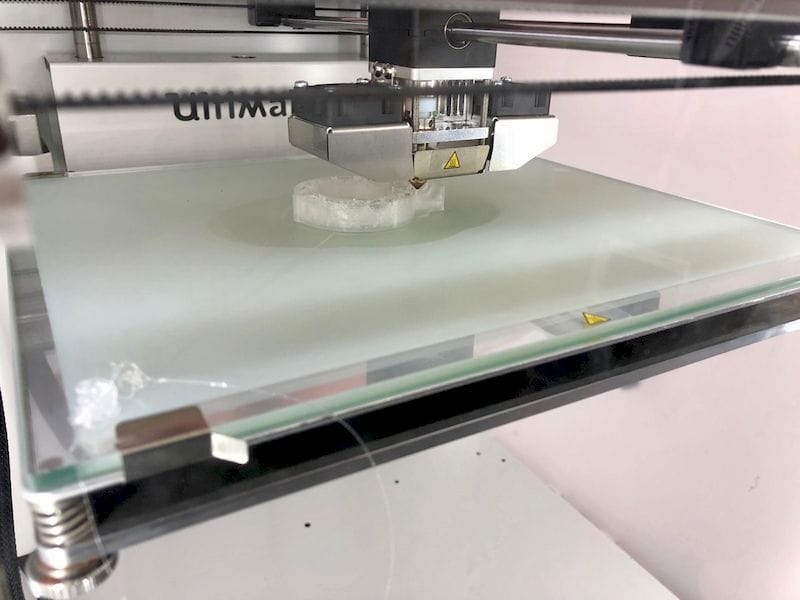
At Formnext, we had a very interesting – and fun – discussion with Ultimaker’s SVP of Product Management, Paul Heiden.
We reviewed aspects of Ultimaker’s strategy that I had never heard from representatives of the company, but after the chat, things are quite clear.
This is part 1 of a 2 part interview. Part 2 is here.
Fabbaloo: Cura Connect was your latest announcement, a very impressive system. I’ve been using cloud systems from a few other vendors like MakerBot’s, or OctoPrint, where it just brings the machine “closer to you” and it just makes it easier. It’s just more “encouraging” to print. And now I see you folks doing the same thing. But what was most interest to me was this: Cura Connect should allow you to sell big blocks of machines to institutions at one time, more easily, because clients simply just have to worry about the capital for acquiring the machines and less for the staff to look after them, because the work is being automated. Is that part of your strategy?
Paul Heiden: Well. No. Well, it could be. But that’s not how it started. When we launched the Ultimaker 3 that was the moment that we really got into the enterprise market. And it wasn’t the small or medium enterprise, it was actually the big enterprises that adopted Ultimaker.
Probably they do so because it still requires a lot of knowledge of the material properties side and everything else that they were probably in the best position to quickly adopt it. This is of course is a wonderful case where they still use quite a decent level of knowledge that they need in order to build these tools even though it’s so much faster than they used to be. And what we also see is Ultimaker is coming up on the radar in a really stealth manner.
So you download the software; it’s free. You upgrade the firmware. You got to make a connect. You buy a printer and it’s within your procurement’s process price levels. And the orders are just coming in.
What we noticed is that people were saying we used them a little bit better than the having printers just standing there, and standing there, and so what Cura Connect essentially does is it finds the Ultimakers that are somewhere. Then what it says is, look, everybody who is using this can use this network of printers. So what you do is you simply throw the print job into the queue and the queue does the thinking. It’ll find the machine that has the right configurations in terms of materials because the material identifies itself in terms of the print cores, whether that’s the right size. And if it finds one it brings the print job to that printer. The solution in the beginning had everything to do with finding printers and at least get a better usage.
Fabbaloo: This is so reminiscent of years ago when Microsoft Word was being sold. Individually people would bring copies of it to work and use it because it was better. You ended up with all of these Microsoft installations across the company. Then Microsoft comes in with the enterprise license program later. Is that what you’re doing?
Paul Heiden: It’s totally relevant for me because I was in software for for 20 years; I built authorization management software. At the end the company was acquired by Microsoft. I’m so often say what we’re doing is what Microsoft was doing all the time. Underneath everything you would come in. It’s the whole 90s thing again and it’s actually replacing a Stratasys “mainframe” with an Ultimaker “PC”. It’s totally the same. Now we built a queue. All these old fashioned things again! It’s very funny.
Then you take the next steps as well. So when we were able to do that we said well that we better have an overview of maintenance per printer and centralize that will be in the future. Of course that will be functions like ordering more material out of Cura. The way you said it, that you’re “bringing these printers closer” is exactly the point. That’s exactly what we’re trying to achieve.

Fabbaloo: It’s a feeling that you have. I didn’t realize it until we started doing it and you think “yeah, the printer is right there”. I can start to print right from these mobile devices, if I wanted to. That’s a powerful thing.
Paul Heiden: Then we learned that people with only one printer are also very happy with the queue because usually there are four or five people working around the printer so they can just put their print jobs in there and when they’re done, they’re going to start doing other things. But again it’s about creating some network software that works well for printers. That’s what mostly inspired me.
The other thing is we’ve still got that in our genes. You talk a lot with the community and everybody’s listening. But this is the type of information you to get only from market research. What do you like about our printer? What do you do not appreciate? You need to talk to people to get input. Then we learned that people were saying, “Look if you’re going to build something like network and queue functionality: No more stuff. No cloud. Nothing, nothing, nothing! just be as stealth as possible. So that’s why we built the server into the machine itself.
Fabbaloo: Having been in corporate IT for years, I know exactly what you’re talking about.
Paul Heiden: Because it’s an impediment to buying printers. It doesn’t meet “the standards” so you cannot do anything. What we did is we built the server on PC board within the printer. When Cura detects the printer, it uses one printer as the “host”. Then it collects the other printers.
Fabbaloo: As long as you’re on the same network?
Paul Heiden: Exactly. The security is basically determined by the security of the local area network. BMW, Apple, they are all saying “Please do it that way. No cloud, because it’ll stop the adoption of 3D printing. That’s how we got to this architecture.
This is part 1 of a 2 part interview. Part 2 is here.

